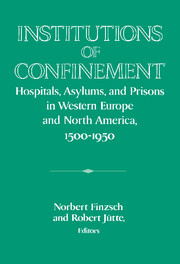 Institutions of Confinement
Institutions of Confinement The Development of Insane Asylums in Germany
Published online by Cambridge University Press: 05 January 2013
Since the earliest part of the nineteenth century, the historiography of psychiatry, especially the prehistory of modern asylums, has been imprinted by myths. The romantic physician Johann Christian Reils (1759-1813) dramatic portrayal of asylums, published in his famous Rapsodieen in 1803, obviously influenced many modern scholars of the subject. The inventor of the term “psychiatry” wrote:
We incarcerate these unhappy creatures in cages like criminals, in deserted jails, next to the dens of owls in waste ravines, above town-gates or in the clammy vaults of penitentiaries, never seen by the compassionate philanthropist, chained up and mouldering in their own dirt.
At the beginning of the nineteenth century a break with the past was made. The period of brutal confinement, persecution, and maltreatment of the mentally ill was to be followed by an enlightened medical treatment that was part and parcel of the new bourgeois society. The darker the portrayal of the treatment of insane human beings in the past, the more important and meritorious seemed the new places for the medical and pedagogical treatment of the mentally ill.
A new critical historiography of psychiatry begun in the 1960s argued for a reform or even the closing of insane asylums. These studies reflected the traditionally negative assessments of early modern “madhouses.” Scholars have concluded that although society's methods of repression and exclusion had certainly become more subtle, the eighteenth and nineteenth centuries failed to produce humane or democratic methods of mental health care. Nevertheless, sufficient archival work has not yet been done to justify fully either one of these conclusions.
To save this book to your Kindle, first ensure [email protected] is added to your Approved Personal Document E-mail List under your Personal Document Settings on the Manage Your Content and Devices page of your Amazon account. Then enter the ‘name’ part of your Kindle email address below. Find out more about saving to your Kindle.
Note you can select to save to either the @free.kindle.com or @kindle.com variations. ‘@free.kindle.com’ emails are free but can only be saved to your device when it is connected to wi-fi. ‘@kindle.com’ emails can be delivered even when you are not connected to wi-fi, but note that service fees apply.
Find out more about the Kindle Personal Document Service.
To save content items to your account, please confirm that you agree to abide by our usage policies. If this is the first time you use this feature, you will be asked to authorise Cambridge Core to connect with your account. Find out more about saving content to Dropbox.
To save content items to your account, please confirm that you agree to abide by our usage policies. If this is the first time you use this feature, you will be asked to authorise Cambridge Core to connect with your account. Find out more about saving content to Google Drive.